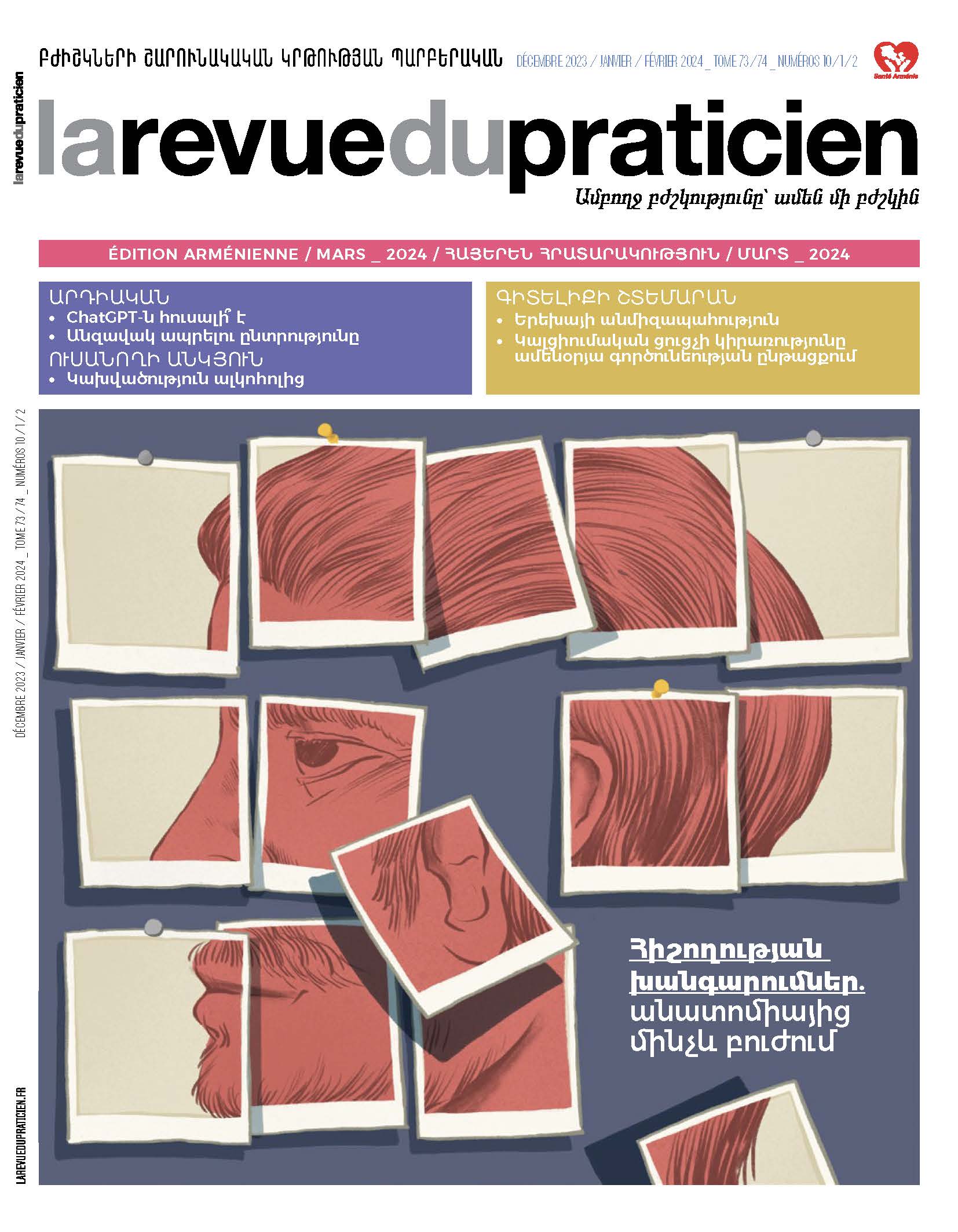Ամփոփագիր
Հիվանդությունները, որոնք տևականորեն ախտահարում են երկարաժամկետ հիշողությունը, բազմաթիվ են, և դրանց համար ընդհանուր է յուրահատուկ նեյրոնային շրջանների անդարձելի և, որպես կանոն, երկկողմանի ախտահարումը: Առաջին շարքում Փապեզի կամ հիպոկամպա-պտկաձևա-տեսաթմբա-գոտկային շղթան է, որը նաև փոխկապակցված է ճակատահիմային շրջանների հետ: Դրա վնասումն առաջացնում է հիշողության դրվագային խանգարումներ՝ իմաստային (սեմանտիկ) հիշողության և ներակա (իմպլիցիտային) ուսուցման հարաբերական պահպանմամբ։ Քունքային առաջային բևեռը գործառութային հանգույց է, որն ապահովում է կեղևում բաշխված ընդհանուր գիտելիքների հասանելիությունը: Դրա ախտահարումը հանգեցնում է ամնեզիայի կլինիկական պատկերի՝ իմաստային հիշողության կորստի գերակշռմամբ: Հիշողության խանգարումների ախտանշանաբանական բազմազանությունը՝ դրանց նրբերանգներով, հիմնականում բխում է ախտահարումների տեղագրությունից: Հիշողության հիվանդությունների ամենատարածված պատճառը նեյրոդեգեներատիվ հիվանդություններն են, որոնց թվում գերակշռում է Ալցհեյմերի հիվանդությունը։ Այդուհանդերձ, դրանց ախտանշանաբանությունը, ախտահարումների տարածման հետ կապված, ամենևին չի սահմանափակվում հիշողության խանգարմամբ: Հիպոկամպերն ընդգրկող աուտոիմուն, վարակային կամ թունահարմամբ պայմանավորված գլխուղեղաբորբերը (էնցեֆալիտները), տեսաթմբերն ու պտկաձև մարմիններն ախտահարող Կորսակովի համախտանիշը և «իմաստային դեմենցիան» այնպիսի կլինիկական պատկերներ են ունենում, որոնցում առաջին պլանում հիշողության խանգարումներն են՝ ուշագրավ ախտանշանաբանական նրբերանգներով: Հետվնասվածքային ամնեզիան ախտահարումների տարաբնույթ լինելու պատճառով առաջացնում է ավելի բարդ կլինիկական պատկեր. հիշողության խանգարումները համալրվում են կատարողական գործառույթների երբեմն էական խանգարումներով:
Résumé
Les maladies qui affectent durablement la mémoire à long terme sont nombreuses et ont en commun de perturber de façon permanente et, en règle, bilatérale des circuits neuronaux spécifiques qui en sont le substratum. Au premier rang figure le circuit de Papez, ou circuit hippocampo-mamillo-thalamo-cingulaire, par ailleurs connecté aux régions frontobasales. Son atteinte engendre des troubles de la mémoire épisodique, avec une relative préservation de la mémoire sémantique et des apprentissages implicites. Le pôle temporal antérieur est quant à lui un noeud fonctionnel permettant d’accéder aux connaissances générales distribuées dans le cortex. Son atteinte donne un tableau amnésique où domine la perte de la mémoire sémantique. La richesse sémiologique des troubles de la mémoire se déduit largement, dans ses nuances, des topographies lésionnelles. La cause la plus fréquente des maladies de la mémoire est représentée par des maladies neurodégénératives, dominées par la maladie d’Alzheimer, mais la sémiologie de celles-ci ne se limite, de loin, pas à un trouble de la mémoire, du fait de la diffusion des lésions. Les encéphalites dysimmunitaires, infectieuses ou toxiques touchant les hippocampes, le syndrome de Korsakoff touchant les thalamus et corps mamillaires, la « démence sémantique » donnent des tableaux où les troubles mnésiques sont au premier plan, avec des nuances sémiologiques remarquables. L’amnésie post-traumatique, en raison de l’hétérogénéité des lésions, offre un tableau plus complexe, où les troubles de la mémoire se complètent de troubles exécutifs parfois majeurs.
Abstract
There are many diseases that permanently affect longterm memory and all of them have in common that they permanently and usually bilaterally disrupt specific neural circuits that underlie it. In the forefront is the Papez circuit, or hippocampo-mamillo-thalamo-cingular circuit, which is also connected to the fronto-basal regions. Its impairment leads to disorders of episodic memory, with relative preservation of semantic memory and implicit learning. The anterior temporal pole is a hub allowing access to general knowledge distributed in the cortex. Its damage results in an amnesic picture in which the loss of semantic memory dominates. The richness of memory disorders is largely deduced, in its nuances, from the lesion topographies. The most frequent aetiology of memory diseases is represented by neurodegenerative diseases, dominated by Alzheimer's disease, but the semiology of these is by far not limited to a memory disorder, because of the diffusion of lesions. Dysimmune, infectious or toxic encephalitis affecting the hippocampi, Korsakoff's syndrome affecting the thalamus and mamillary bodies, « semantic dementia » affecting the temporal pole, give pictures where memory disorders are in the foreground with remarkable semiological nuances. Post-traumatic amnesia, due to the heterogeneity of the lesions, offers a more complex picture, where memory disorders are complemented by executive disorders, sometimes major.
